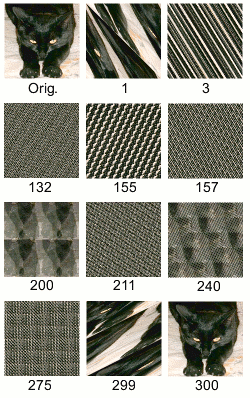This is an old revision of this page, as edited by Giftlite (talk | contribs) at 21:06, 4 November 2009 (+2.). The present address (URL) is a permanent link to this revision, which may differ significantly from the current revision.
Revision as of 21:06, 4 November 2009 by Giftlite (talk | contribs) (+2.)(diff) ← Previous revision | Latest revision (diff) | Newer revision → (diff)In mathematics, Arnold's cat map is a chaotic map from the torus into itself, named after Vladimir Arnold, who demonstrated its effects in the 1960s using an image of a cat.
Thinking of the torus as Arnold's cat map is the transformation given by the formula
Equivalently, in matrix notation, this is
That is, with a unit size equal to the width of the square image, the image is sheared one unit to the right, then one unit up, and all that lies without that unit square is wrapped around on the other respective side to be within it.

Properties
- Γ is invertible because the matrix has determinant 1 and therefore its inverse has integer entries,
- Γ is area preserving,
- Γ has a unique hyperbolic fixed point (the vertices of the square). The linear transformation which defines the map is hyperbolic: its eigenvalues are real numbers, one greater and the other smaller than 1, so they are associated respectively to an expanding and a contracting eigenspace which are also the stable and unstable manifolds. The eigenspace are orthogonal because the matrix is symmetric. Since the eigenvectors have rationally independent components both the eigenspaces densely cover the torus. Arnold's cat map is a particularly well-known example of a hyperbolic toral automorphism, which is an automorphism of a torus given by a square unimodular matrix having no eigenvalues of absolute value 1.
- The set of the points with a periodic orbit is dense on the torus. Actually a point has a periodic orbit if and only if its coordinates are rational.
- Γ is topologically transitive (i.e. there is a point whose orbit is dense)
- The number of points with period n is exactly |λ1 + λ2−2| (where λ1 and λ2 are the eigenvalues of the matrix). For example, the first few terms of this series are 1, 5, 16, 45, 121, 320, 841, 2205 ... . (The same equation holds for any unimodular hyperbolic toral automorphism if the eigenvalues are replaced.)
- Γ is an Anosov diffeomorphism and in particular it is structurally stable.
The discrete cat map

It is possible to define a discrete analogous of the cat map. One of this map's features is that image being apparently randomized by the transformation but returning to its original state after a number of steps. As can be seen in the picture to the right, the original image of the cat is sheared and then wrapped around in the first iteration of the transformation. After some iterations, the resulting image appears rather random or disordered, yet after further iterations the image appears to have further order—ghost-like images of the cat—and ultimately returns to the original image.
The discrete cat map describes the phase space flow corresponding to the discrete dynamics of a bead hopping from site qt (0 ≤ qt < N) to site qt+1 on a circular ring with circumference N, according to the second order equation:
- qt+1 - 3qt + qt-1 = 0 mod N
Defining the momentum variable pt = qt - qt-1, the above second order dynamics can be re-written as a mapping of the square 0 ≤ q, p < N (the phase space of the discrete dynamical system) onto itself:
- qt+1 = 2qt + pt mod N
- pt+1 = qt + pt mod N
This Arnold cat mapping shows mixing behavior typical for chaotic systems. However, since the transformation has a determinant equal to unity, it is area-preserving and therefore invertible the inverse transformation being:
- qt-1 = 2qt - pt mod N
- pt-1 = -qt + pt mod N
For real variables q and p, it is common to set N = 1. In that case a mapping of the unit square with periodic boundary conditions onto itself results.
When N is set to an integer value, the position and momentum variables can be restricted to integers and the mapping becomes a mapping of a toroidial square grid of points onto itself. Such an integer cat map is commonly used to demonstrate mixing behavior with Poincaré recurrence utilising digital images. The number of iterations needed to restore the image can be shown never to exceed 3N.
For an image, the relationship between iterations could be expressed as follows:
- n = 0: T(x,y) = Input Image (x,y)
- n = 1: T(x,y) = T(mod(2x+y,N),mod(x+y,N))
- .
- .
- .
- n = k: T(x,y) = T(mod(2x+y,N),mod(x+y,N))
- .
- .
- .
- Output Image(x,y) = T(x,y)
See also
References
- *Template:Fr icon V. I. Arnold (1967). Problèmes Ergodiques de la Mécanique Classique. Paris: Gauthier-Villars.
{{cite book}}: Unknown parameter|coauthors=ignored (|author=suggested) (help); English translation: V. I. Arnold (1968). Ergodic Problems in Classical Mechanics. New York: Benjamin.{{cite book}}: Unknown parameter|coauthors=ignored (|author=suggested) (help) - Franks, John M. Invariant sets of hyperbolic toral automorphisms. American Journal of Mathematics, Vol. 99, No. 5 (Oct., 1977), pp. 1089–1095
- http://www2.research.att.com/~njas/sequences/A004146
- Period of a discrete cat mapping , Freeman J. Dyson and Harold Falk, American Mathematical Monthly 99 603-614 (1992).
External links
- Weisstein, Eric W. "Arnold's Cat Map". MathWorld.
- A description and demonstration, using an image of the Earth as an example
- Effect of randomisation of initial conditions on recurrence time
- Arnold's Cat Map by Enrique Zeleny, The Wolfram Demonstrations Project.
- Arnold's Cat Map, David Arnold.
 as
as  Arnold's cat map is the transformation
Arnold's cat map is the transformation  given by the formula
given by the formula

